Rose Anderson's Blog, page 19
January 28, 2015
Blow…
Every once in a while I have breathing issues. That case of pneumonia early last year didn’t do my asthma any favors. My recent new year health scare reminded me I need to work on my lungs. My daughter was recently in Peru and she brought back two native wind instruments for me – a wooden flute and a set of panpipes. The finger holes on the flute give me trouble, but I’m doing ok on the panpipes. I love Andean pipe music so I play along with my various CDs.
 Wind instruments are old. Millennia ago someone picked up a reed, animal horn, or a hollow bone and blew through it. With a few adjustments that simple tube concept became all the wind instruments created since. Some wind instruments disappeared over time. Others spread around the world. Some stayed relatively simple while others became elaborate things. All of them make unique sounds. Early on, musicians figured out different sounds could be made by adding holes. Someone noticed even more sounds could be made by adding reed slivers to narrow the mouthpiece, a gourd to amplify the sound, or a membrane to vibrate against the breath.
Wind instruments are old. Millennia ago someone picked up a reed, animal horn, or a hollow bone and blew through it. With a few adjustments that simple tube concept became all the wind instruments created since. Some wind instruments disappeared over time. Others spread around the world. Some stayed relatively simple while others became elaborate things. All of them make unique sounds. Early on, musicians figured out different sounds could be made by adding holes. Someone noticed even more sounds could be made by adding reed slivers to narrow the mouthpiece, a gourd to amplify the sound, or a membrane to vibrate against the breath.
Did you ever try to make music with tissue over a comb?
I’m a drummer. My main musical talent is working out drumbeats and creating rhythm on synthetic and hide drums. Everyone knows drums are percussion instruments, but few realize they are also considered membranophones. Not a glamorous-sounding name is it? A membranophone is any musical instrument that produces sound with a vibrating stretched membrane. On a drum that would be the drum head. Membranophones come in more forms besides the drum. It also includes wind instruments like onion flutes, eunuch flutes (yes you read that right) and mirlitons (not the chayote). A mirliton is a kazoo. Yes, a kazoo was once a serious instrument. And today is…
:)
More~
http://mentalfloss.com/article/29859/great-moments-kazoo-history
http://www.hmtrad.com/catalog/articles/kazoo.html
~❋~❋~❋~
 Phraseology
Phraseology
I often wonder where certain words and sayings come from. For the next few weeks this word collector will be examining some familiar phrases to get at their heart. I think you’ll be surprised.
The phrase for today is ~ Face the music.
Everyone knows this phrase has to do with accepting the unpleasant results of one’s actions, but opinions are divided on just where this phrase comes from. One opinion has to do with actors being on stage and facing the orchestra pit. That sounds pretty weak to me. If this were so, how does the current meaning fit? The other opinion is this phrase refers to a military reprimand or court martial . A drum head would be used as an improvised writing table for a court martial or formal reprimand held in the field. You’d face the drum to hear your sentence, and the slang meaning becomes obvious. Makes sense to me.
~❋~❋~❋~
 Today our guest is Author Jane Leopold Quinn
Today our guest is Author Jane Leopold Quinn
http://romancebooks4us.blogspot.com/
Romance Books ‘4’ Us ~ Our February contest is coming up. http://www.romancebooks4us.com
~❋~
If you enjoy my daily musings, subscribe to get them sent to your inbox, or if your inbox is as packed as mine is, check out the Networked Blogs tab on the right and get all the blogs you follow in one daily notice. A new year full of curious and compelling posts awaits!
 Sample my scorching love stories for free!
Sample my scorching love stories for free!
~❋~


January 27, 2015
Here be Dragons
 I was one of those kids who always saw the pictures hidden in things –things like animals in clouds, faces in wood, and larger geometric patterns within patterns that repeated.
I was one of those kids who always saw the pictures hidden in things –things like animals in clouds, faces in wood, and larger geometric patterns within patterns that repeated.
I recall my 3rd grade epiphany when I happened to look at the huge canvas map of the world hanging on the classroom wall. I saw that the western edge of North and South America fit exactly into the eastern edge of Africa. I asked the teacher about it and she said it was a coincidence. Not so. Years later I learned the continents were once connected exactly there and together the large land mass was called Pangaea. Ever since I was a little girl, I’ve always been drawn to maps. Not for the places and roads on them, but because of their shapes within shapes. For other people, it was all about the places.
Here’s an interesting timeline of geographic history, streamlined to fit a morning blog post:
The first city map ever discovered was created in stone in 2300 BCE for the city of Lagash, Mesopotamia.
In 450 Herodotus compiled a map of the known world.
In 334 Alexander the Great set to conquering the Middle East and India.
In 240 Eratosthenes calculated the circumference of the earth.
In 20 AD Greek geographer Strabo published his 17 volume Geography.
In 77 AD Pliny the Elder wrote his Encyclopedia of Geography.
In 150 Ptolmy the Greco-Egyptian polymath published his Geography that included a coordinate grid system a map and places labeled.
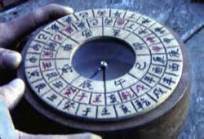 A lot of changes
both large and small
took place from Ptolmy’s time on in to the 1100s. Things like Mt, Vesuvius’ eruption, the fall of Rome, the Crusades, and the discovery of the magnetic compass.
A lot of changes
both large and small
took place from Ptolmy’s time on in to the 1100s. Things like Mt, Vesuvius’ eruption, the fall of Rome, the Crusades, and the discovery of the magnetic compass.
In 1154 Edrisi the Arabic scholar published his book of world geography. He was famous for his planisphere– the most accurate map of Europe, north Africa and western Asia.
 More changes rocked the world between the 1100s and 1400s. China ruled the seas, there were more crusades, and the Bubonic plague killed approximately 60% of Europeans.
More changes rocked the world between the 1100s and 1400s. China ruled the seas, there were more crusades, and the Bubonic plague killed approximately 60% of Europeans.
In 1410 A translation of Ptolemy’s Geography was published in Europe
1418 Portugal’s Prince Henry the Navigator established the Sagres Research Institute.
Collectively, the 1400 and 1500s were big in geography.
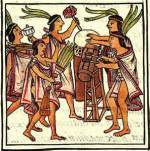 Spanish and
Portuguese
explorers
made new and profitable discoveries. They also
established trading posts in the new world and throughout Africa. Magellan began his circumnavigation of the earth.
Spanish and
Portuguese
explorers
made new and profitable discoveries. They also
established trading posts in the new world and throughout Africa. Magellan began his circumnavigation of the earth.
In 1569 Flemish geographer and cartographer Gerardus Mercator created his map and coined the word Atlas for a collection of maps.
In 1675 the Royal Observatory was established at Greenwich, England. This is important because here we have the Prime Meridian –longitude defined at 0°.
In 1714 the British government offered a 20,000£ reward to anyone who could accurately determine longitude at sea. It’s all about time.
In 1761 John Harrison’s chronometer did just that — accurately determined longitude at sea.
In 1768-1779 James Cook explored the earth.
In 1804-1806 Lewis and Clark explored the western United States.
In 1817 German geographer Karl Ritter published his first volume of Die Erkunde (The Explorers).
In 1830 the Royal Geographical Society was formed in London.
In 1840 the Geological Survey of Canada was established.
In 1850 the first use of the camera for mapping takes place in France.
In 1851 the American Geographical Society was formed.
In 1855 Matthew Fontaine Maury, the “father of naval oceanography” publishes his Physical Geography of the Sea.
In 1867 the United States Geological Survey (USGS) was established.
In 1874 the first Department of Geography was established in Germany.
In 1884-1885 Berlin Conference divides Africa among European colonial powers.
And… On this day in 1888 the world’s largest nonprofit scientific and education institution was founded for “the increase and diffusion of geographical knowledge.” We know this as The National Geographic Society. It was conceived by a diverse group of geographers, explorers, teachers, cartographers, military officers, and financiers who all shared an interest in scientific and geographical knowledge. They felt “Americans were becoming more curious about the world around them.” Indeed, that magazine, and all that went with it, opened the door to the world for many a rural American. Oh for those days when an ignorant population didn’t equate education with elitist snobbery, but as a way to better oneself and the lives of their children.
On this day in 1888 the world’s largest nonprofit scientific and education institution was founded for “the increase and diffusion of geographical knowledge.” We know this as The National Geographic Society. It was conceived by a diverse group of geographers, explorers, teachers, cartographers, military officers, and financiers who all shared an interest in scientific and geographical knowledge. They felt “Americans were becoming more curious about the world around them.” Indeed, that magazine, and all that went with it, opened the door to the world for many a rural American. Oh for those days when an ignorant population didn’t equate education with elitist snobbery, but as a way to better oneself and the lives of their children.
More~
100 Years of National Geographic Maps
The famous National Geographic Magazine
A lengthy historical look at Longitude (part 1) http://youtu.be/SSGHOifF_oI
(part 2) http://youtu.be/IfxXJPmKzo4
~❋~❋~❋~
 Phraseology I often wonder where certain words and sayings come from. For the next few weeks this word collector will be examining some familiar phrases to get at their heart. I think you’ll be surprised.
Phraseology I often wonder where certain words and sayings come from. For the next few weeks this word collector will be examining some familiar phrases to get at their heart. I think you’ll be surprised.
The phrase for today is ~ Here be Dragons
It’s a fanciful phrase today, but it has more to do with the terrifying unknown than lighthearted dragon mythology. It was common practice among map makers to jazz up their uncharted seas and grounds with pictures of fantastic and often terrifying beasts. Remember, the earth was flat in their minds. They knew of whales and giant squid so those unknown things that lay beyond the edges had to be even more frightful.
One such map was the copper Lenox Globe (circa mid-1500s). Written on the eastern coast of Asia, the globe says “hic sunt dracones” and from Latin that translates to Here are dragons.
~❋~❋~❋~
 Today is Author Janice Seagraves’ blog day. http://romancebooks4us.blogspot.com/
Today is Author Janice Seagraves’ blog day. http://romancebooks4us.blogspot.com/
Romance Books ‘4’ Us ~ Our February contest is coming up. http://www.romancebooks4us.com
~❋~
If you enjoy my daily musings, subscribe to get them sent to your inbox, or if your inbox is as packed as mine is, check out the Networked Blogs tab on the right and get all the blogs you follow in one daily notice. A new year full of curious and compelling posts awaits!
 Sample my scorching love stories for free!
Sample my scorching love stories for free!
~❋~


January 26, 2015
Nose to the grindstone
I had a mentally busy week last week. I’m up to my eyebrows in a story right now. Since the muse went packing after my old puppy died, this burst of creativity is not something I can turn my back on. Strike while the iron is hot, gather ye rosebuds while ye can, sail with the tide, and carpe diem, I say.
:D
So, yeah, I’m busy writing my next novel. Still, I couldn’t resist blogging a special day — It’s World Rock Stacking Day. It’s a little hard for me to do with my nearby river frozen over like it is, so I’m sharing it here just in case those of you in milder climes want to try.
 If you’ve never heard of this before, to some, rock stacking is a sort of performance art along the lines of what nature artist Andy Goldsworthy does. To others, balancing stones atop one another is a meditative process. I can see that. I’ve tried stone stacking on a small scale and it certainly is a peaceful activity, though not an easy one. You must be aware of each breath you take. Try it sometime and I think you’ll agree. You need not balance boulders. A handful of pebbles from the garden or park work just as well.
If you’ve never heard of this before, to some, rock stacking is a sort of performance art along the lines of what nature artist Andy Goldsworthy does. To others, balancing stones atop one another is a meditative process. I can see that. I’ve tried stone stacking on a small scale and it certainly is a peaceful activity, though not an easy one. You must be aware of each breath you take. Try it sometime and I think you’ll agree. You need not balance boulders. A handful of pebbles from the garden or park work just as well.
I came across this youtube gem recently. It’s a shorter artsier version of a lengthier clip (see additional link below). I think the narration adds a whole other dimension to stone balancing. As I said, some find this a mediation. I hope you enjoy.
More~
http://www.thehappyscientist.com/science-experiment/rock-stacking
The longer version http://youtu.be/kHVLi8LA_0Q
The Inuit culture also balanced stones. http://inuitinukshuk.com/
~❋~❋~❋~
 Phraseology I often wonder where certain words and sayings come from. For the next few weeks this word collector will be examining some familiar phrases to get at their heart. I think you’ll be surprised.
Phraseology I often wonder where certain words and sayings come from. For the next few weeks this word collector will be examining some familiar phrases to get at their heart. I think you’ll be surprised.
The phrase for today is ~ Keep your nose to the grindstone.
Thoughts are divided as to just where this phrase comes from. In common use, it means work without rest, but that’s far different from what it really means.
Some think it has to do with the miller sniffing the grindstone periodically to detect the smell of burning grain. With all the chaff and flour in the air, a fire would be something to be watchful of. As plausible as this meaning appears at first glance, that stone would be a millstone not a grindstone.
Were we to look to early citations of the phrase from the 1600s to determine exactly what it means, they suggest it’s actually a form of punishment. Holding a knife or axe to a grindstone sharpens 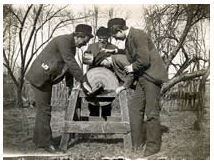 the metal. Imagine someone’s nose to the grindstone for a crime they committed. Yikes. The phrase’s original meaning faded with time but was apparently known for what it was around the turn of the last century when this photograph was staged. >>>
the metal. Imagine someone’s nose to the grindstone for a crime they committed. Yikes. The phrase’s original meaning faded with time but was apparently known for what it was around the turn of the last century when this photograph was staged. >>>
I’ll say it again — Yikes.
~❋~❋~❋~
 Today is Author Sam Cheever’s blog day. http://romancebooks4us.blogspot.com/
Today is Author Sam Cheever’s blog day. http://romancebooks4us.blogspot.com/
Romance Books ‘4’ Us ~ Our February contest is coming up. http://www.romancebooks4us.com
~❋~
If you enjoy my daily musings, subscribe to get them sent to your inbox, or if your inbox is as packed as mine is, check out the Networked Blogs tab on the right and get all the blogs you follow in one daily notice. A new year full of curious and compelling posts awaits!
 Sample my scorching love stories for free!
Sample my scorching love stories for free!
~❋~


January 25, 2015
Fun Day Sunday & Weekend Happenings
 If you’ve been here before then you know Sundays on my blog are all about wonder and smiles. In honor of mentally kicking back once in a while, Sundays are Fun Days! Each Sunday, visitors will find a fun, interesting, or unusual something here. I’m a nerd with a complex sense of humor and absurd wit. It could literally be anything.
If you’ve been here before then you know Sundays on my blog are all about wonder and smiles. In honor of mentally kicking back once in a while, Sundays are Fun Days! Each Sunday, visitors will find a fun, interesting, or unusual something here. I’m a nerd with a complex sense of humor and absurd wit. It could literally be anything.
I’ve been super busy with a deadline so the blogging lapsed last week. Sometimes you just have to put all those creative eggs in one basket.
I have something interesting to share today — a look at historical archery technique. My husband got me into archery when we were dating. I really enjoy it. It took a while to learn how to aim and not painfully twang my inner forearm with the bowstring, but I eventually learned to be a fair shot. For me, archery has a strange inconsistency similar to throwing darts. I can hit the bulls-eye fairly often but the occasional stray happens, and when it does it’s waaaaay off target. Huh. No rhyme or reason to it. The good news is I haven’t killed anyone yet. Yet. ;)
;)
The following clip brings up some very interesting archery points taken from historical manuscripts and they’re nothing like Erroll Flynn used in Robin Hood. This archer is amazing.
❋❋❋
My Other Weekend Happenings
Weekend Writing Warriors
http://theancillarymuse.blogspot.com/
My Sexy Saturday & Sexy Snippets
http://calliopesotherwritingtablet.blogspot.com/
Sunday Snippet
**A promo op for you too!**
http://exquisitequills.blogspot.com/
❋❋❋
 Sample my scorching love stories for free!
Sample my scorching love stories for free!
❋❋❋
 Today our guest is Author Karen McCullough.
http://romancebooks4us.blogspot.com/
Today our guest is Author Karen McCullough.
http://romancebooks4us.blogspot.com/
Romance Books ‘4’ Us ~
Our January contest is on and we have prizes!
http://www.romancebooks4us.com
❋❋❋❋❋


January 18, 2015
Fun Day Sunday & Weekend Happenings
 If you’ve been here before then you know Sundays on my blog are all about wonder and smiles. In honor of mentally kicking back once in a while, Sundays are Fun Days! Each Sunday, visitors will find a fun, interesting, or unusual something here. I’m a nerd with a complex sense of humor and absurd wit. It could literally be anything.
If you’ve been here before then you know Sundays on my blog are all about wonder and smiles. In honor of mentally kicking back once in a while, Sundays are Fun Days! Each Sunday, visitors will find a fun, interesting, or unusual something here. I’m a nerd with a complex sense of humor and absurd wit. It could literally be anything.
I had no idea a bird would do something like this. After seeing it I wondered if this was just a peculiar habit for one peculiar lovebird. It’s not! Check these out…
Wow. What do you suppose each little guy is thinking while he’s getting himself dolled up? I often wondered what went through my cockatiel’s mind when she used to go after my pincushion. She’d pull pins and needles from it one by one, walk them to the edge of the table and then drop them on the floor. She stay on task until the pincushion was plucked clean.
:)
❋❋❋
My Other Weekend Happenings
Weekend Writing Warriors
http://theancillarymuse.blogspot.com/
My Sexy Saturday & Sexy Snippets
http://calliopesotherwritingtablet.blogspot.com/
Sunday Snippet
**A promo op for you too!**
http://exquisitequills.blogspot.com/
❋❋❋
 Sample my scorching love stories for free!
Sample my scorching love stories for free!
❋❋❋
 Today our guest is Author J.D. Faver.
http://romancebooks4us.blogspot.com/
Today our guest is Author J.D. Faver.
http://romancebooks4us.blogspot.com/
Romance Books ‘4’ Us ~
Our January contest is on and we have prizes!
http://www.romancebooks4us.com
❋❋❋❋❋


January 16, 2015
Serendipity
 Origins~
Origins~
There are so many things in our lives that we take for granted. Simple things like spoons and combs and toilet paper weren’t around when early man left the savannahs of Africa for parts unknown. Those things had to be invented by people who saw a need and devised a better way. Spoons and combs are infinitely better than fingers, and without question toilet paper is superior to leaves or handfuls of sand(!)
Many things we know and love came about with a dash of serendipity. For instance, the soap we know today was surely started from a combination of circumstances at the hearth — wood ash and water make lye. Fat from cooked meats when exposed to lye sets off a chemical reaction. Taken together, ash, water, and fat make soap. The thing is, serendipity requires someone to notice something. Then it takes someone to do it again on purpose.
This business of noticing and perfecting serendipitous events takes many forms. Alexander Fleming’s discovery of penicillin is one such moment of serendipity. Corn Flakes breakfast cereal is another. In fact, many episodes of serendipity built up over time actually lead us right to cookies.
 Humble Cookies
Humble Cookies
After consuming one too many cookies during the holidays, I’m still keeping them at arm’s length until spring. If you stop to think about it, the humble cookie owes its existence to many unrelated serendipitous events. Off the top of my head — Flour: Hunter gatherers harvested wild grains wherever they came across the plants until someone thought it would be easier to put the seed where they wanted it to grow. Then someone thought the largest most robust seeds were best. Then someone cultivated only the best. From there we have agriculture.
Other things factor in to the cookie‘s background. Take animal domestication. Eggs and butter for human use came about much the same as agriculture did. It was just easier to keep the birds in one place and take their eggs as needed and borrow milk from lactating goats, cows, and sheep you kept in a pen. Other components required someone to notice them first before they became perfected processes. Yeast, for example, floated through the air and helped bread to rise and liquids to ferment. Someone had to notice the changes and wonder why. Baking powder came about because a scientist thought to help his wife whose allergy to yeast prevented her from enjoying breads. Making sugar from various plant juices began when someone figured out when sweet juice evaporated it left sweeter crystals behind. Again, someone had to notice. These are just the main ingredients. There’s more! Peanut butter and chocolate chip cookies have very complicated beginnings:
Peanut butter >> Global exploration to South America (global exploration consists of its own pile of serendipitous events) >> cultivation >> Peanuts tweaked by George Washington Carver’s personal inspiration.
Chocolate Chips >> Bitter Cacao used by Olmec, Maya and Aztec civilizations>>>Global exploration to South America >>cocoa tweaked by the Dutch>>>Ruth Wakefield chops up a chocolate bar to add to her sugar cookie dough and invents the first chocolate chip cookie in 1937 – the Toll House Cookie.
Add to all of the above what it took to turn iron ore into steel baking pans and utensils. Add to this fuel production for our stoves. And finally, add the myriad this and thats I’ve forgotten. Connections between disparate things and events always fascinate me.
:)
So why am I talking cookies today? It’s National Fig Newton Day.
More~
http://whatscookingamerica.net/History/CookieHistory.htm
http://www.thenibble.com/REVIEWS/MAIN/cookies/cookies2/cookie-history.asp
Cookie fact: To test oven temperature before baking a large cake, Dutch cooks would bake a little batter first. These little test cakes were called koekje or little cake.
~❋~❋~❋~
 Phraseology
Phraseology
I often wonder where certain words and sayings come from. For the next few weeks this word collector will be examining some familiar phrases to get at their heart. I think you’ll be surprised.
The phrase for today is ~As the Cookie Crumbles
Like the French C’est la vie ( such is life) As the Cookie Crumbles is one of those certainty phrases that refer to our accepting the unpredictable fortunes of existence. Variations include that’s the way it goes and that’s the way the ball bounces. As far as I’ve been able to discover, this slang term appears in print in America sometime in the 1920s. Hey, cookies have crumbs. It’s a sure thing.
~❋~❋~❋~
 Today is Author Jean Hart Stewart’s blog day. http://romancebooks4us.blogspot.com/
Today is Author Jean Hart Stewart’s blog day. http://romancebooks4us.blogspot.com/
Romance Books ‘4’ Us ~ Our January contest is on!
Lots of prizes.
http://www.romancebooks4us.com
~❋~
If you enjoy my daily musings, subscribe to get them sent to your inbox, or if your inbox is as packed as mine is, check out the Networked Blogs tab on the right and get all the blogs you follow in one daily notice. A new year full of curious and compelling posts awaits!
 Sample my scorching love stories for free!
Sample my scorching love stories for free!
~❋~


January 15, 2015
Nothing is better for thee
 I took a break from writing midday yesterday and did a little light web surfing while I had lunch. Too late I discovered I missed International Kiss a Ginger Day on Monday. I laughed when I saw the event was made in response to the International Kick a Ginger Day. Kick? really? Hmm. This redhead would welcome a kiss but likely clobber the person who tried to kick me over the color of my hair. lol Who makes up this stuff?
I took a break from writing midday yesterday and did a little light web surfing while I had lunch. Too late I discovered I missed International Kiss a Ginger Day on Monday. I laughed when I saw the event was made in response to the International Kick a Ginger Day. Kick? really? Hmm. This redhead would welcome a kiss but likely clobber the person who tried to kick me over the color of my hair. lol Who makes up this stuff?
:P
 Following wacky things…Did you know January is National Oatmeal Month? No kidding. The humble oat wasn’t always a delicious belly-warming good-for-your-heart meal. Prior to the early 1800’s, oats were considered horse and cattle fodder and therefore suitable grain for the poor only. I couldn’t find out why that was. So belly up to the breakfast table, add that dash of brown sugar and cinnamon and maybe a spoonful of almonds and raisins to your porridge. I have a mini history post for you to read while you eat.
Following wacky things…Did you know January is National Oatmeal Month? No kidding. The humble oat wasn’t always a delicious belly-warming good-for-your-heart meal. Prior to the early 1800’s, oats were considered horse and cattle fodder and therefore suitable grain for the poor only. I couldn’t find out why that was. So belly up to the breakfast table, add that dash of brown sugar and cinnamon and maybe a spoonful of almonds and raisins to your porridge. I have a mini history post for you to read while you eat.
:)
The oldest known oats as they relate to man were found in Egypt and date to the12th Dynasty ( 2,000 B.C. E.). These were uncultivated oats, meaning they were harvested from the wild. Evidence of cultivated oats date back to the Bronze Age. Of people who would know such things, many believe our present cultivated oat developed as a mutation in wild oats in Asia Minor or southeastern Europe some 2000 years ago. Perhaps one patch of wild oats had more grains or larger ones and that difference made it worthwhile to pick and grow the grain on purpose. (Man has been tweaking plant output for a very long time. Were you to compare the first corn with today’s hybrids, you wouldn’t think they were the same species). In North America, oats were first grown on the Elizabeth Islands, off the coast of Massachusetts in 1602. Even George Washington got in on oats. Between the Revolutionary War and his presidency, he “sowed 580 acres of oats on his land” in Virginia.
So, oats were grown and consumed all across Europe, but it wasn’t  eaten the ways we enjoy it today. Only salt was added, if that. Whole or cracked grains were often cooked into a thick porridge and consumed over several days. When the porridge was firm enough, it was sliced and fried. So essential was this grain, there were even superstitions about cooking it wrong. One of these says the porridge should be stirred only using the right-hand and in a clockwise direction to ward off evil spirits.
eaten the ways we enjoy it today. Only salt was added, if that. Whole or cracked grains were often cooked into a thick porridge and consumed over several days. When the porridge was firm enough, it was sliced and fried. So essential was this grain, there were even superstitions about cooking it wrong. One of these says the porridge should be stirred only using the right-hand and in a clockwise direction to ward off evil spirits.
More~
Here’s a fun site with more.
http://www.foodreference.com/html/a-oatmeal-cookies-907.html
130 years!
http://www.quakeroats.com/about-quaker-oats/content/quaker-history.aspx
The Great Exchange
http://www.vos.noaa.gov/MWL/dec_08/great_exchange.shtml
~❋~❋~❋~
 Phraseology
Phraseology
I often wonder where certain words and sayings come from. For the next few weeks this word collector is going to examine some familiar phrases to get at their heart. I think you’ll be surprised.
The phrase for today is ~ Cat got your tongue?
This phrase is directed at anyone caught being curiously quiet. This one makes an appearance in print in the early 1880s, though there is some thought that it’s actually much older than seeing it 1800s’ print suggests. There are many urban myth origins surrounding Cat got your tongue. Here are three:
One myth comes from a sailor being unable to speak as he was being flogged by the cat-o-nine-tails.
A myth from the middle ages that says a witch’s cat will curl up by a sleeping baby to steal the baby’s breath. No breath, no voice.
Another says the phrase originates with a cat’s “irreverent view of property” — as in they’d even take the tongue right out of your mouth!
Likely, as cat’s move quick when they pounce on their prey, your sudden quiet could only mean you were pounced upon and your tongue was taken before you realized it was gone. Phrases of lighthearted imagery like this are often attributed to children and referred to as playground parlance. They don’t make sense and that’s okay.
~❋~❋~❋~
 Today is Author Fran Lee’s blog day. http://romancebooks4us.blogspot.com/
Today is Author Fran Lee’s blog day. http://romancebooks4us.blogspot.com/
Romance Books ‘4’ Us ~ Our January contest is on!
Lots of prizes.
http://www.romancebooks4us.com
~❋~
If you enjoy my daily musings, subscribe to get them sent to your inbox, or if your inbox is as packed as mine is, check out the Networked Blogs tab on the right and get all the blogs you follow in one daily notice. A new year full of curious and compelling posts awaits!
 Sample my scorching love stories for free!
Sample my scorching love stories for free!
~❋~


January 14, 2015
Mackerel Scales & Mares’ Tails
 I’ve just finished walking the terrier. Oh how this little clown loves snow. How fun to sniff out mouse trails below the surface. The sun isn’t fully up yet so I got to see something magical. Here in the upper Midwest last night, the temperature was just high enough to sublimate the snow.
I’ve just finished walking the terrier. Oh how this little clown loves snow. How fun to sniff out mouse trails below the surface. The sun isn’t fully up yet so I got to see something magical. Here in the upper Midwest last night, the temperature was just high enough to sublimate the snow.
I just love that word. It’s related to sublime and that means to make higher, nobler… purer. In this case, subliming occurs when a solid (snow) turns into a vapor (fog) without turning into a liquid (water) first. The result? Hoarfrost (hoar meaning hairy). The fog froze on all surfaces as the temperature fell overnight. This morning every twig looks as though it has been coated in diamond dust. Just lovely.
If you’ve stopped by my blog recently you’ve read how my area was in the path of an Alberta Clipper weather system last week. The fast-moving winter storm is named for Alberta, Canada, because that’s generally where they begin before they speed from the Pacific to the Atlantic Ocean. I discovered they also form in other places along the Pacific coast and have colorfully different names depending where. That’s the stuff that sparks my imagination!
My morning blog topics generally follow whatever strikes my fancy while having that first cup of coffee. Throughout January, depending on my writing mood, I’ll be talking on and off about all those fanciful weather names.
Today I’m sharing two cloud features that come with their own nautical proverbs.
Mares’ Tails~
These are cirrus uncinus clouds formed by 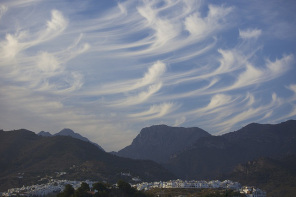 ice crystals in the upper troposphere. They get their name from their fluffy elongated shape that indicates strong winds at high altitudes – a sure sign of an approaching weather front.
ice crystals in the upper troposphere. They get their name from their fluffy elongated shape that indicates strong winds at high altitudes – a sure sign of an approaching weather front.
Mackerel Scales~
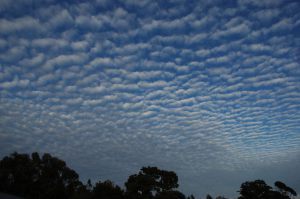
These mid-level clumpy altocumulus clouds resemble the skin patterns on the speckled fish they’re named for. They’re a sure sign of atmospheric instability and are the harbinger for heavy rains in the near future.
If sailors of old saw these cloud formations together, they knew it was time to lower the sails because the coming weather would bring high winds. High winds meant trouble for tall masted ships, hence these proverbs:
Mackerel scales and mare’s tails, make lofty ships carry low sails.
Mackerel in the sky, three days dry.
Mackerel sky, mackerel sky. Never long wet and never long dry.
More~
Speaking of sails…I found this very interesting.
~❋~❋~❋~
 Phraseology
Phraseology
I often wonder where certain words and sayings come from. For the next few weeks this word collector is going to examine some familiar phrases to get at their heart. I think you’ll be surprised.
The phrase for today is ~ Taken aback.
This phrase began as a nautical term. Aback refers to what happens with the sails of a ship when the wind is bearing hard against their fronts and they’re laid back against the mast. To be taken aback means the sudden change of wind or bad steering. We use it today to mean suddenly and unexpectedly lose control, be disconcerted or disappointed.
~❋~❋~❋~
 Today is Author Marianne Stephens’ blog day. http://romancebooks4us.blogspot.com/
Today is Author Marianne Stephens’ blog day. http://romancebooks4us.blogspot.com/
Romance Books ‘4’ Us ~ Our January contest is on!
Lots of prizes.
http://www.romancebooks4us.com
~❋~
If you enjoy my daily musings, subscribe to get them sent to your inbox, or if your inbox is as packed as mine is, check out the Networked Blogs tab on the right and get all the blogs you follow in one daily notice. A new year full of curious and compelling posts awaits!
 Sample my scorching love stories for free!
Sample my scorching love stories for free!
~❋~


January 13, 2015
Screamers, Maulers, & Pineapples
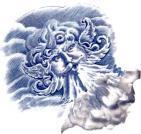 The word Storm comes from a Proto-Germanic word that means a violent and noisy commotion — sturmaz.
The word Storm comes from a Proto-Germanic word that means a violent and noisy commotion — sturmaz.
Have you ever wondered how names stick? What inspired the first person to attach a name to something? More curious, how was it he or she got everyone else to buy into the naming?
The other day I read up on the Alberta Clipper weather system that usually starts in Alberta, Canada, and blows all the way to the Atlantic Ocean. I discovered the same storm had different names depending where it began. When a writer sees names like Saskatchewan Screamer and Manitoba Mauler, the imagination kicks in to high gear! Needless to say, when this info hound’s imagination gets tickled, that means it’s a topic worth examining a bit more.
:)
Here’s another weather system with an evocative name ~
 Pineapple Express
Pineapple Express
A Pineapple Express — literally a weather system fueled by an atmospheric river that travels from Hawaii to the Western United States. Atmospheric river conjures its own imagery, doesn’t it?
This powerful storm is fueled by a stream of tropical moisture that originates off the Hawaiian Islands. (Hawaii = pineapples, hence the name.) Once formed, the Pineapple Express tends to linger. Fueled by its river of moisture, it often dumps torrential rainfall, even at higher elevations where it contributes to mudslides and flash floods.
It basically works like this: There’s a 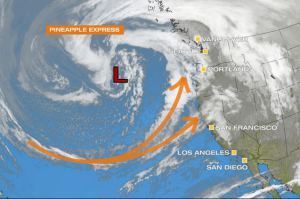 semi-high pressure area located over the eastern Pacific Ocean. This deflects storms north-westward across North America. In the winter months, this high pressure area weakens and allows the jet stream to steer those mid-latitude weather systems it doesn’t normally have access to the rest of the year. At the same time, a high-pressure system over the Gulf of Alaska blocks the polar jet stream. Weather systems forming over the warm Pacific Ocean tend to be moisture heavy, so the result is a storm with long duration and very heavy rainfall. Because of this continuous feed of tropical moisture, the main problem with the Pineapple Express is they are likely to dump a year’s worth of precipitation in a week. They also come with hurricane winds, tornadoes, flooding, and landslides.
semi-high pressure area located over the eastern Pacific Ocean. This deflects storms north-westward across North America. In the winter months, this high pressure area weakens and allows the jet stream to steer those mid-latitude weather systems it doesn’t normally have access to the rest of the year. At the same time, a high-pressure system over the Gulf of Alaska blocks the polar jet stream. Weather systems forming over the warm Pacific Ocean tend to be moisture heavy, so the result is a storm with long duration and very heavy rainfall. Because of this continuous feed of tropical moisture, the main problem with the Pineapple Express is they are likely to dump a year’s worth of precipitation in a week. They also come with hurricane winds, tornadoes, flooding, and landslides.
Who knew such a whimsical name came with such a terrible personality?
Tomorrow ~ one more.
~❋~❋~❋~
 Phraseology
Phraseology
I often wonder where certain words and sayings come from. For the next few weeks this word collector is going to examine some familiar phrases to get at their heart.
The phrase for today is ~ Turn a blind eye.
It means a willful refusal to acknowledge some particular reality. Curiously, the phrase begins with British naval hero Admiral Lord Horatio Nelson before his distinguished career took off and he himself became the stuff of legend.
As the story goes, when the British navy was up against the large Danish-Norwegian fleet during the Battle of Copenhagen in 1801. The conservative superior officer commanding the British fleet flagged his ships to withdraw. It was here that the young Horatio Nelson (who previously lost an eye in Corsica) put his telescope to his bad eye and told the men, “I really do not see the signal.” Fact or fiction, however it was, they went on fighting and he went on to score a decisive victory. Most historians refer to this as a battlefield myth.
:)
~❋~
 Today is Author Cindy Spencer Pape’s blog day. http://romancebooks4us.blogspot.com/
Today is Author Cindy Spencer Pape’s blog day. http://romancebooks4us.blogspot.com/
Romance Books ‘4’ Us ~ Our January contest is on!
Lots of prizes.
http://www.romancebooks4us.com
~❋~
If you enjoy my daily musings, subscribe to get them sent to your inbox, or if your inbox is as packed as mine is, check out the Networked Blogs tab on the right and get all the blogs you follow in one daily notice. A new year full of curious and compelling posts awaits!
 Sample my scorching love stories for free!
Sample my scorching love stories for free!
~❋~


January 12, 2015
What’s in a name?
 A while back, I blogged about the winds and how the ancients connected weather to the whim of the gods. Before my health scare last Thursday, I had written about the Alberta Clipper weather system that was blowing through my area. That left me thinking about how we name weather.
A while back, I blogged about the winds and how the ancients connected weather to the whim of the gods. Before my health scare last Thursday, I had written about the Alberta Clipper weather system that was blowing through my area. That left me thinking about how we name weather.
One weather event I can think of off the top of my head is the hurricane. To begin, according to the American Meteorological Society, the word hurricane is a Spanish corruption of the Carib Indian name for Hunraken, the Mayan storm god. Aptly named if you think about it, for who else but a storm god could wield that much power?
The study of this 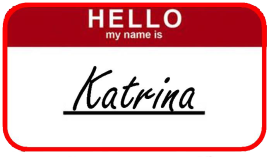 weather phenomena was a relatively new science up to the 1940s. Before then, hurricanes that regularly appeared on our coasts weren’t officially named unless they proved severe, and even then they were more likely named for the place or day they wrought the most damage. The Galveston Hurricane of 1900 was one worth noting.
weather phenomena was a relatively new science up to the 1940s. Before then, hurricanes that regularly appeared on our coasts weren’t officially named unless they proved severe, and even then they were more likely named for the place or day they wrought the most damage. The Galveston Hurricane of 1900 was one worth noting.
You can tell at a glance where the Galveston Hurricane took place, but unless you looked it up, you’d never know where the Labor Day Hurricane of 1935 occurred. Some time passed before someone decided to differentiate one hurricane from another by naming them individually. The very first hurricane to take on a person’s name was 1947’s Hurricane George. I couldn’t find a reason it was named George. Apparently it was an “unofficial naming”.
Interestingly enough, the next hurricane was named Hurricane Bess, after First Lady Bess Truman. Again, I can’t find a reason for this naming. Bess Truman was a rather sedate president’s wife (Harry Truman 1949). It’s not like her personality blew into town and caused havoc. Perhaps it was just out of respect — power of the office/ power of the storm? Who knows. Naming hurricanes was hit or miss until 1953. That year the powers that be decided to use women’s names from A to Z, A being first in line. Perhaps this went with the adage Hell hath no fury like a woman scorned coined by William Congreve 1697. Or perhaps it was a nod to the old maritime habit of referring to ships as she. However naming hurricanes after women began, this trend would continue until 1979. It’s all unisex now.
More~
The names are picked years ahead of time.
I remember this one. I also recall the tagline “Camille was no lady”.
A little extra — Classifying hurricanes.
http://www.uscg.mil/lantarea/camslant/hurricane/classification.asp
~❋~
 This weather naming business has me thinking about phraseology. Why do we choose words the way we do? Rather than start another 100 Words, I think this would be a fine A to Z topic to mull for a while.
This weather naming business has me thinking about phraseology. Why do we choose words the way we do? Rather than start another 100 Words, I think this would be a fine A to Z topic to mull for a while.
The phrase for today is…
A Cappella
Now here’s a convoluted phrase. The singing style refers to singing unaccompanied in chapel. But look a little deeper and you find the Old French word chapele. Go deeper still to the Latin and you get cappella, the hooded cape worn by men of the church. Sing like the robed men in church do — A Cappella.
I just love words.
:)
~❋~
 Today is Author Gemma Juliana’s blog day. http://romancebooks4us.blogspot.com/
Today is Author Gemma Juliana’s blog day. http://romancebooks4us.blogspot.com/
Romance Books ‘4’ Us ~ Our January contest is on!
Lots of prizes.
http://www.romancebooks4us.com
~❋~
If you enjoy my daily musings, subscribe to get them sent to your inbox, or if your inbox is as packed as mine is, check out the Networked Blogs tab on the right and get all the blogs you follow in one daily notice. A new year full of curious and compelling posts awaits!
 Sample my scorching love stories for free!
Sample my scorching love stories for free!
~❋~






